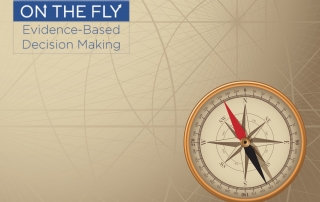
EBDM On the Fly 2: The secret sauce for successful leaders
Let’s get to the heart of the matter:
What are the core things you must do as a leader? Is there a secret sauce that can add flavor to your many roles?
Millions of words have been published on this topic. At one time or another, you’ve probably heard that the essential function of leadership is to: […]
Even cows need good data
We came across this article the other day and have to admit, it gave us a chuckle. Of course, we’re fans of data in all its many forms, but being based in downtown Seattle, we don’t get many chances to think about it in the context of cows – er, make that calving management.
But the article provides fodder for a crunchy little morsel of usefulness. The author explains that there is an existing method for collecting data on dystocia (cows with difficult labor in delivering calves). It’s been around since 1978, and involves a five-point scale. The scale ranges from 1 – no problems in delivery, 2 – slight problem, 3 – assistance needed, 4 – considerable force required (we’re picturing an episode of James Herriot’s All Creatures Great and Small), to 5 – extreme difficulty or surgical intervention.
The controversy involves a new proposed scale from 1 (no problems), 2 (one-person pull) to 3 (severe traction or surgery). On an intuitive level, this sounds nice and simple, right? Who needs those extra points on the scale anyway?
Well, dairies do. Reducing the spectrum from five points down to three means that the resulting data will be less sensitive to what’s really going on. And that makes it less reliable for decision making.
Moral of the story? Pay attention not only to the data being collected, but the metrics used to collect it. Simpler is not always better. […]
EBDM On the Fly 3: The 30,000 foot view
Rooted in the health sciences where it goes by the moniker “evidence-based practice,” in recent years evidence-based decision making (EBDM) has rapidly evolved as a means of improving the quality of decisions, adapting to diverse applications. As an organizational leader who is on the lookout for ways to improve your skills and effectiveness, you may have heard of EBDM.
But others may be asking, “What exactly is EBDM, anyway?”
As with any rapidly developing practice, definitions differ. A lot, in fact. But for our purposes, here’s an “on the fly” definition that forms the backbone of this series:
Evidence-based decision making (EBDM) is a process for interpreting and organizing information gathered systematically from diverse sources to create a testable model of the relative effectiveness of alternative programs, policies, or practices.
Whew. There are a lot of moving parts in there. Having a firm grasp of the meaning of each element is crucial to the practice of EBDM, and this series will unpack them one by one. […]
Save the Census data!
Good data is necessary – but not sufficient in itself – for evidence-based decision making. After all, you can’t make an evidence-based decision without evidence, right?
That’s why it’s dismaying that the folks at the Census are considering removing a crucial set of items when the next Census comes around in 2020. […]
EBDM On the Fly 4: Anatomy of a decision
So far we’ve identified two basic skills for leadership success:
- .
- Learn systematically from the less-than-good decisions.
Chances are, at this point some readers are muttering under their breath: “Well, all this talk about decisionmaking being the heart of leadership and the importance of evidence is fine, but it all depends on how you define ‘decision’ and ‘evidence’, right?”
—to which I reply, “Exactly. Let’s do that.”
What is a decision, anyway?
There’s a surprising lack of consensus. Many definitions imply that decisionmaking is a purely cognitive exercise. In this view, a decision is the result of a rigorous mental process carried out by an individual in isolation: “A conclusion or resolution reached after consideration.”
Other sources assert that decisions are fundamentally an expression of individual moral character (“firmness of purpose”)—in this view, an authentic decision is more of an unbending personal statement than a nuanced and goal-directed response to circumstances.
Do those perspectives on decisionmaking ring true in your experience? Frankly, we think they miss the mark, because most real-world decisions don’t look like that. Most leaders in the trenches simply don’t identify with Rodin’s Thinker—bronze brow furrowed in noble concentration as he wrestles in solitude with deep and thorny principles. Does that sound like your workday? […]
Strategic Planning is Dead
A recent article in the Stanford Social Innovation Review succinctly makes the case for adaptive strategic planning—that is, a planning process that doesn’t attempt to predict the future, but rather encourages a culture of experimentation, learning, and adaptation.
Since at least World War II, the prevailing approach to strategic planning in the business, governmental and nonprofit world has been rooted in traditional military thinking and culture. Based on centuries of hard-won experience, this approach assumes:
- The past is always the best predictor of the future.
- Good data is hard to come by, so new information should be greeted with skepticism.
- Lines of communication are generally unreliable. Therefore a small number of clear directives, not often changed, are essential in order to coordinate the far-flung elements of our operation.








